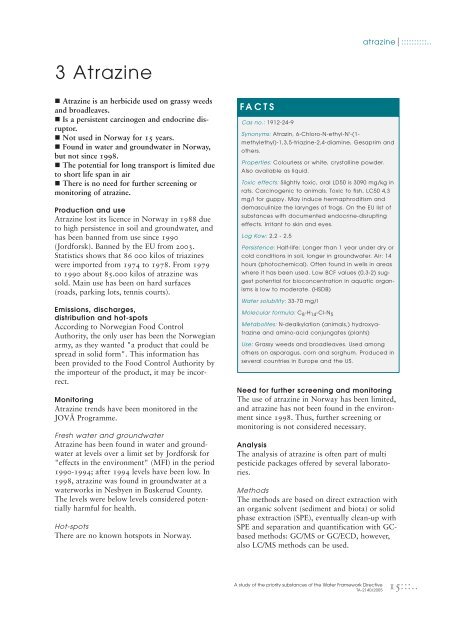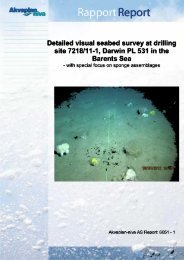A study of the priority substances of the Water Framework Directive ...
A study of the priority substances of the Water Framework Directive ...
A study of the priority substances of the Water Framework Directive ...
Create successful ePaper yourself
Turn your PDF publications into a flip-book with our unique Google optimized e-Paper software.
3 Atrazine<br />
� Atrazine is an herbicide used on grassy weeds<br />
and broadleaves.<br />
� Is a persistent carcinogen and endocrine disruptor.<br />
� Not used in Norway for 15 years.<br />
� Found in water and groundwater in Norway,<br />
but not since 1998.<br />
� The potential for long transport is limited due<br />
to short life span in air<br />
� There is no need for fur<strong>the</strong>r screening or<br />
monitoring <strong>of</strong> atrazine.<br />
Production and use<br />
Atrazine lost its licence in Norway in 1988 due<br />
to high persistence in soil and groundwater, and<br />
has been banned from use since 1990<br />
(Jordforsk). Banned by <strong>the</strong> EU from 2003.<br />
Statistics shows that 86 000 kilos <strong>of</strong> triazines<br />
were imported from 1974 to 1978. From 1979<br />
to 1990 about 85.000 kilos <strong>of</strong> atrazine was<br />
sold. Main use has been on hard surfaces<br />
(roads, parking lots, tennis courts).<br />
Emissions, discharges,<br />
distribution and hot-spots<br />
According to Norwegian Food Control<br />
Authority, <strong>the</strong> only user has been <strong>the</strong> Norwegian<br />
army, as <strong>the</strong>y wanted "a product that could be<br />
spread in solid form". This information has<br />
been provided to <strong>the</strong> Food Control Authority by<br />
<strong>the</strong> importeur <strong>of</strong> <strong>the</strong> product, it may be incorrect.<br />
Monitoring<br />
Atrazine trends have been monitored in <strong>the</strong><br />
JOVÅ Programme.<br />
Fresh water and groundwater<br />
Atrazine has been found in water and groundwater<br />
at levels over a limit set by Jordforsk for<br />
"effects in <strong>the</strong> environment" (MFI) in <strong>the</strong> period<br />
1990-1994; after 1994 levels have been low. In<br />
1998, atrazine was found in groundwater at a<br />
waterworks in Nesbyen in Buskerud County.<br />
The levels were below levels considered potentially<br />
harmful for health.<br />
Hot-spots<br />
There are no known hotspots in Norway.<br />
FACTS<br />
Cas no.: 1912-24-9<br />
Synonyms: Atrazin, 6-Chloro-N-ethyl-N'-(1methylethyl)-1,3,5-triazine-2,4-diamine,<br />
Gesaprim and<br />
o<strong>the</strong>rs.<br />
Properties: Colourless or white, crystalline powder.<br />
Also available as liquid.<br />
Toxic effects: Slightly toxic, oral LD50 is 3090 mg/kg in<br />
rats. Carcinogenic to animals. Toxic to fish, LC50 4,3<br />
mg/l for guppy. May induce hermaphroditism and<br />
demasculinize <strong>the</strong> larynges <strong>of</strong> frogs. On <strong>the</strong> EU list <strong>of</strong><br />
<strong>substances</strong> with documented endocrine-disrupting<br />
effects. Irritant to skin and eyes.<br />
Log Kow: 2,2 - 2,5<br />
Persistence: Half-life: Longer than 1 year under dry or<br />
cold conditions in soil, longer in groundwater. Air: 14<br />
hours (photochemical). Often found in wells in areas<br />
where it has been used. Low BCF values (0,3-2) suggest<br />
potential for bioconcentration in aquatic organisms<br />
is low to moderate. (HSDB)<br />
<strong>Water</strong> solubility: 33-70 mg/l<br />
Molecular formula: C 8 -H 14 -Cl-N 5<br />
Metabolites: N-dealkylation (animals,) hydroxyatrazine<br />
and amino-acid conjungates (plants)<br />
Use: Grassy weeds and broadleaves. Used among<br />
o<strong>the</strong>rs on asparagus, corn and sorghum. Produced in<br />
several countries in Europe and <strong>the</strong> US.<br />
atrazine ::::::::::..<br />
Need for fur<strong>the</strong>r screening and monitoring<br />
The use <strong>of</strong> atrazine in Norway has been limited,<br />
and atrazine has not been found in <strong>the</strong> environment<br />
since 1998. Thus, fur<strong>the</strong>r screening or<br />
monitoring is not considered necessary.<br />
Analysis<br />
The analysis <strong>of</strong> atrazine is <strong>of</strong>ten part <strong>of</strong> multi<br />
pesticide packages <strong>of</strong>fered by several laboratories.<br />
Methods<br />
The methods are based on direct extraction with<br />
an organic solvent (sediment and biota) or solid<br />
phase extraction (SPE), eventually clean-up with<br />
SPE and separation and quantification with GCbased<br />
methods: GC/MS or GC/ECD, however,<br />
also LC/MS methods can be used.<br />
A <strong>study</strong> <strong>of</strong> <strong>the</strong> <strong>priority</strong> <strong>substances</strong> <strong>of</strong> <strong>the</strong> <strong>Water</strong> <strong>Framework</strong> <strong>Directive</strong><br />
TA-2140/2005<br />
15:::..

















